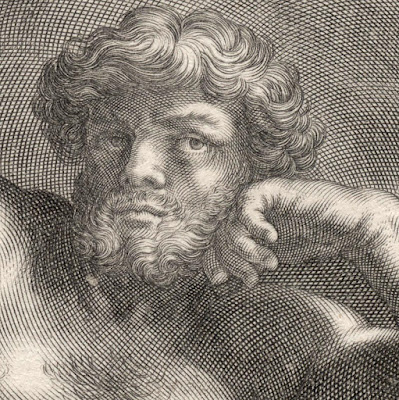Cornelis
Bloemaert (1603–1692)
“Vulcanus” (upper image) and “Apollo” (lower image), c.1677, from the series of
15 unnumbered plates, “Heroicae virtutis imagines” (Images of heroic deeds) and
a series of 4 plates after Pietro da
Cortona’s (1597–1669) frescoes in the Palazzo Pitti in Florence,
published by Giovanni Giacomo de' Rossi
(1627–1691) in Rome.
Two etchings with engraving on laid paper with margins as
published, glued together and stamped with a collector’s ink seal.
Size of the two-sheet glued assemblage: 50.3 x 39.2 cm
Size of upper etching: (sheet) 25.6 x 39.2 cm; (plate) 19.8 x 34.3
cm; (lunette image borderline) 16.4 x 33.4 cm
Size of lower etching: (sheet) 26.5 x 39.2 cm; (plate) 19.7 x 34.4
cm; (lunette image borderline) 16.7 x 33.2 cm
Lettered on both plates below the image borderline (with minor
differences): (left) 'Eq. Petrus Beretinus Corton. pinx. Florentiae in aedib.
Sereniss. Magni Ducis Hetrur. in camera Iovis”; (centre) “Io. Iacobus de Rubeis
formis Romae ad Templ. Pacis cu Priv. S. Pont.” (right) “Cornel. Bloemart
sculp.”
The British Museum offers the following description of the upper
etching, “Vulcanus” (Hollstein Dutch 75):
“Vulcan seated at centre, resting his head on his left arm, two
Cyclops at far left, metalwork at right, smoke and fire in the background,
after Pietro da Cortona's lunette in the Sala di Giove of the Palazzo Pitti in
Florence”
See also the description of “Vulcanus” at the Rijksmuseum: http://hdl.handle.net/10934/RM0001.COLLECT.482317
The British Museum offers the following description of the lower
etching, “Apollo” (Hollstein Dutch 75):
“Apollo as a young nude male reclining, head turned to the left,
holding the lyre in left hand, landscape with trees in the background, after
Pietro da Cortona's lunette …”
See also the description of “Apollo” at the Rijksmuseum:
Condition: both prints are crisp impressions and in good condition
for their age (i.e. there are no tears, holes, folds, significant abrasions,
stains or foxing) with only minimal signs of handling in terms of minor surface
marks. The glued assemblage is skilfully handled by a past collector whose oval
seal is stamped towards the centre of the glued sections.
I am selling this very elegant—and very rare—assemblage of prints showing
classical Greek gods with their symbolic attributes (e.g. Vulcan with his
hammer, anvil, fire tongs, forge/volcano crater and Apollo with his quiver and
lyre), for the total cost of AU$239 (currently US$178.29/EUR149.98/GBP131.13 at
the time of posting these etchings) including postage and handling to anywhere
in the world.
If you are interested in purchasing this large and impressive
grouping of two important prints by one of the most famous of the 17th
century old masters, please contact me (oz_jim@printsandprinciples.com) and I
will send you a PayPal invoice to make the payment easy.
Note: In my next post I will be offering the remaining two prints
from the same series of four plates.
This print has been sold
What I admire about this pair of prints is how well the figures in
the lunette compositions are arranged in space. For instance, in the upper
image, “Vulcanus”, the god of fire is shown reclining away from us so that his left
foot—rendered with awful foreshortening—seems almost to push against the
picture plane. The reason that I point out this small feature is that his foot
helps to establish the perception that the lunette shape of the image is
actually a three-dimensional hemisphere like a snowdome (https://en.wikipedia.org/wiki/Snow_globe).
This concept of creating a contained three-dimensional space
within a transparent form is an underpinning principle of the Roman Baroque style
and Pietro da Cortona is a master of this practice. Regarding his compositions
for the Palazzo Pitti that Bloemaert reproduces here, the British Museum goes
further and proposes that his frescoes “inaugurated a new relationship in art
between three-dimensional stuccowork and illusionistic paintings contained
within heavy, stuccoed frames” (http://www.britishmuseum.org/research/search_the_collection_database/term_details.aspx?bioId=128438).








No comments:
Post a Comment
Please let me know your thoughts, advice about inaccuracies (including typos) and additional information that you would like to add to any post.